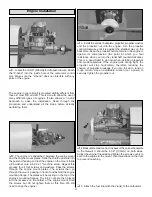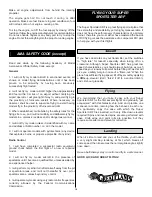
❏
6. Assemble the two wing halves with the tightest seam
possible.
No gaps
should be showing between the two
halves. Use a paper towel dampened with alcohol to wipe
away any more epoxy that oozes out of the wing Use
several strips of masking tape on both sides of the wing to
hold them securely together. Let the epoxy fully cure before
continuing.
❏
Note:
The exact dihedral angle (the angle at which the
wings are “bent up”) is not considered critical. This angle is
established by the angle of the root ribs and the dihedral
brace. As long as the wing halves fit together tightly, the
dihedral angle will be correct. If you wish to check the
dihedral angle, place one wing panel flat on your work
surface. The opposite wing panel should measure
approximately 1-7/8" [77mm] between the work surface and
the bottom of the wing.
❏
7. Starting at the aft edge of the aileron servo tray, apply
the 1/2" [13mm] white wing center-section tape completely
around the wing over the joint. A small amount of pressure
should be applied to make a smooth seam.
❏
8. Prepare the aileron servo with grommets and bushings
as shown in the sketch. Test fit the aileron servo into the
servo tray. Note that the notch in the tray corresponds to the
location of the servo lead wire. Enlarge the opening in the
servo tray, if needed, using a sharp hobby knife or fine
toothed file if needed. There should be a gap of about 1/64"
[.5mm] between the servo and the servo tray when installed
properly.
❏
9. Drill 1/16" [1.5mm] pilot holes for the servo mounting
screws. Mount the servos with the screws provided with
your radio system. With the servo centered, trim and install
the servo horn as shown in the photo.
❏
10. Thread the aileron control horns onto the torque rods
until they are positioned 1" [25mm] above the wing.
❏
11. Locate two plastic clevises, two 6" [152mm] aileron
pushrods and clevis retainer. Thread the clevises 14-turns
onto the rods. Slide the clevis retainer down the rod and
partially over the clevis.
7






































